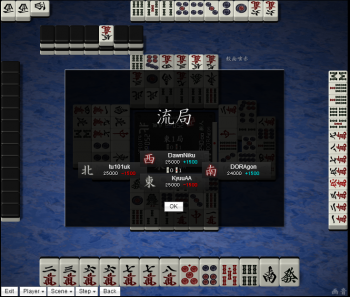Ryuukyoku: Difference between revisions
No edit summary |
|||
| Line 29: | Line 29: | ||
== Hand progression == | == Hand progression == | ||
{{main|Hanchan}} | |||
Often, a hand may end in a draw, where players had declared riichi. Any leftover [[riichi]] bets on the table are placed near the counters until collected by the winner of a hand. If the dealer is not in tenpai, then the seat winds rotate normally. If the dealer is in tenpai, the seat winds remain the same for the next hand. | Often, a hand may end in a draw, where players had declared riichi. Any leftover [[riichi]] bets on the table are placed near the counters until collected by the winner of a hand. If the dealer is not in tenpai, then the seat winds rotate normally. If the dealer is in tenpai, the seat winds remain the same for the next hand. | ||
Revision as of 23:34, 7 February 2014

Ryuukyoku 「流局」 is also known as an exhaustive draw. Sometimes, all the tiles aside from the dead wall are drawn, and no player manages to produce a winning hand. In this case, players in tenpai reveal their hands and receive points from those in noten (players not in tenpai). Players in noten may choose to reveal their hands, but it is not required. Doing does not affect the point exchanges.
Nearly 40% of professional games go to an exhaustive draw due to players immediately dropping out of the race when a player declares riichi.
Wind seating may or may not occur depending on the dealer's hand. If the dealer is tenpai, then the wind seating does not rotate; and on the other hand, wind seating does rotate if the dealer fails to develop a tenpai hand. Though rules may be modified to require the dealer to win the hand, rather than just simply attaining tenpai.
Tenpai
In the event of ryuukyoku, no hand wins after all the tiles, with exception to tiles in the dead wall and players' hands are drawn and discarded. However, hands at tenpai during ryuukyoku still has some value.
Point exchanges
If some players are tenpai and some are not, a total exchange of 3,000 points are evenly split between among the tenpai players from the noten players.
Point exchanges are as follows:
- 0 players in tenpai: No points exchanged.
- 1 player in tenpai: All players in noten pays 1,000 points to the tenpai player.
- 2 players in tenpai: Each player in noten pays 1,500 points, each player in tenpai receives 1,500 points.
- 3 players in tenpai: The single player in noten plays 1,000 points to each player in tenpai.
- 4 players in tenpai: No points exchanged.
Hand progression
Often, a hand may end in a draw, where players had declared riichi. Any leftover riichi bets on the table are placed near the counters until collected by the winner of a hand. If the dealer is not in tenpai, then the seat winds rotate normally. If the dealer is in tenpai, the seat winds remain the same for the next hand.
The count for honba keeps track of the number of consecutive hands, by which no one has won a hand. Every time ryuukyou or even tochuu ryuukoku (abortive draw) occurs, this count increases by one. Barring house rules, the count may or may not increase regarding chombo. When a player wins a hand, the count resets back to zero.
External links
- Ryuukyoku in Japanese Wikipedia